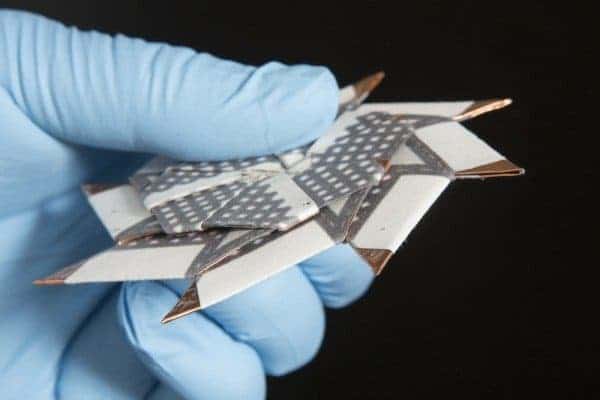An engineer from Binghamton University, State University of New York designed a new disposable battery that could power biosensors and other small devices in areas where conventional batteries are just too expensive. The battery only uses one drop of dirty water to generate energy. But the best part — it folds up like an origami ninja star.
Seokheun Choi, assistant professor of computer and electrical engineering at Binghamton University, working with two of his students developed the new device that’s powered by the bacteria found in dirty water. This isn’t Choi’s first origami battery — his first design was shaped like a matchbox and consisted of four modules stacked together. The star version is made out of eight small batteries connected in a series, measures in at around 6.35 centimeters (2.5 inches) wide and has a better power output and increased voltage than the first one.
“Last time, it was a proof of concept. The power density was in the nanowatt range,” said Choi. “This time, we increased it to the microwatt range. We can light an LED for about 20 minutes or power other types of biosensors.”
Paper-based biosensors are currently used for pregnancy and HIV tests, but their sensitivity is limited says Choi. His battery could allow these sensors to employ fluorescent or electrochemical biosensors with a much better accuracy, even in developing countries.
“Commercially available batteries are too wasteful and expensive for the field,” he said. “Ultimately, I’d like to develop instant, disposable, accessible bio-batteries for use in resource-limited regions.”
The battery unfolds into a star with one inlet at its center and the electrical contacts at the points of each side. After adding a few drops of dirty water on the inlet and the device can be opened into a Frisbee-like shape, allowing each of the eight fuel cells to function. Each module is a sandwich of five functional layers with its own anode, proton exchange membrane and air-cathode.
While Choi’s first battery could be produced for about 5 US cents, the star is a bit more expensive — roughly 70 US cents. This is because the battery is also made with carbon cloth for the anode and copper tape in addition to the filter paper. The team plans to produce a fully paper-based device that has the power density of the new design with lower price tag.










